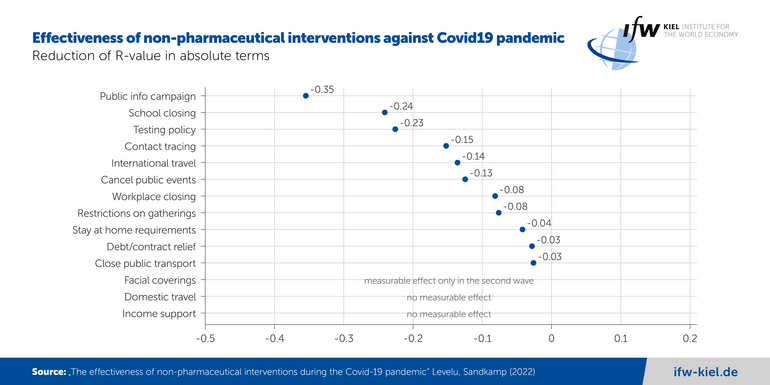News
Covid-19: info campaigns, school closures and testing successful means of containment

Covid-19 testing (-0.23), contact tracing (-0.15), and international travel restrictions (-0.14) also contributed to a significant reduction in the reproduction rate (R-value). Cancellation of public events, reduction of presence in companies, for example through home office, and restrictions on private meetings, for example via a maximum number of people, also lowered the R-value. For all measures, the stricter the application, the more successful it is in reducing the R-value.
Wearing masks did not produce statistically measurable success in the first wave of Covid-19, but did so in the second wave. This is presumably because masks were worn more consistently and people switched from community masks to medical masks. Local travel restrictions for example had no measurable effect on infection control.
"However, the decision on which measures to implement (first) also depends on their economic and social impacts. Measures that are effective while causing relatively few distortions should be implemented first, such as information campaigns, testing, contact tracking, and mask wearing," says Alexander Sandkamp who does research on international trade at the Kiel Institute for the World Economy.
Together with Anthonin Levelu (Paris Dauphine University) he analyzed 14 so-called non-pharmaceutical interventions to contain the Covid-19 pandemic and their association with the R-value in 182 countries in 2020 using statistical methods. Medical measures such as vaccination or treatments by medical personnel were not examined. Their study "A lockdown a day keeps the doctor away: The effectiveness of non-pharmaceutical interventions during the Covid-19 pandemic", has now been published as a Kiel Working Paper.

"The high effectiveness of information campaigns can probably be explained by their role as amplifiers for many other measures. They are likely to have significantly increased people's willingness to implement infection control measures in the first place, such as wearing masks correctly, keeping distance, or reducing contacts," says Sandkamp. "The other measures also often have both a direct and an indirect effect on new infections. By making people aware of the gravity of the situation, they influence their general behavior even beyond the respective restriction."
The authors evaluated large-scale data from outside the U.S. and China, including Germany. To date, there have been only few such studies. The results relate to the effectiveness of the measures on average across all countries investigated and are in principle also transferable to future pandemics.
"The results clearly demonstrate the effectiveness of the analyzed measures to combat the Covid-19 pandemic, even though the exact extent may differ across countries. The study thus also provides the scientific justification for infection control measures that is often demanded by policymakers," says Sandkamp.
